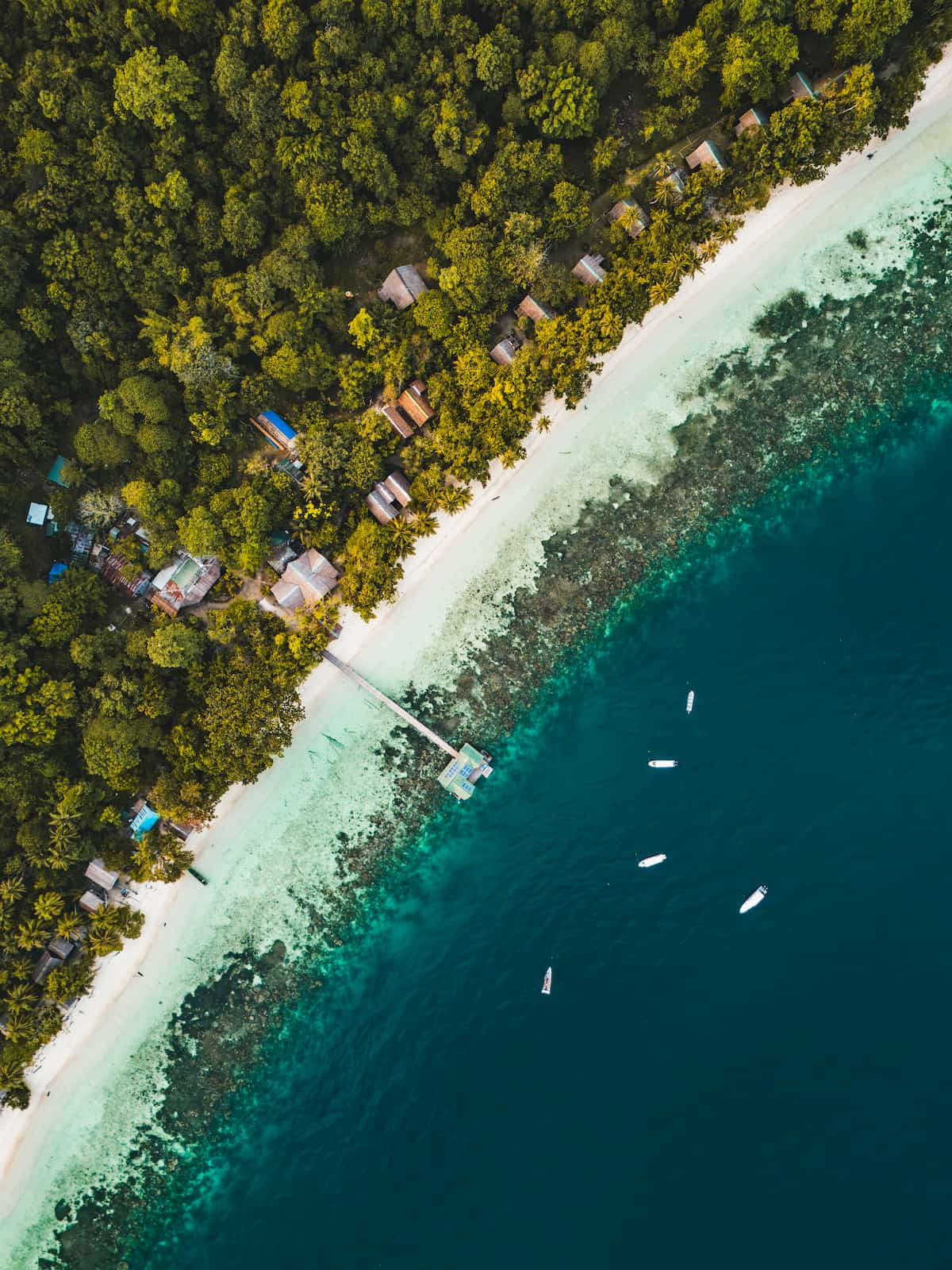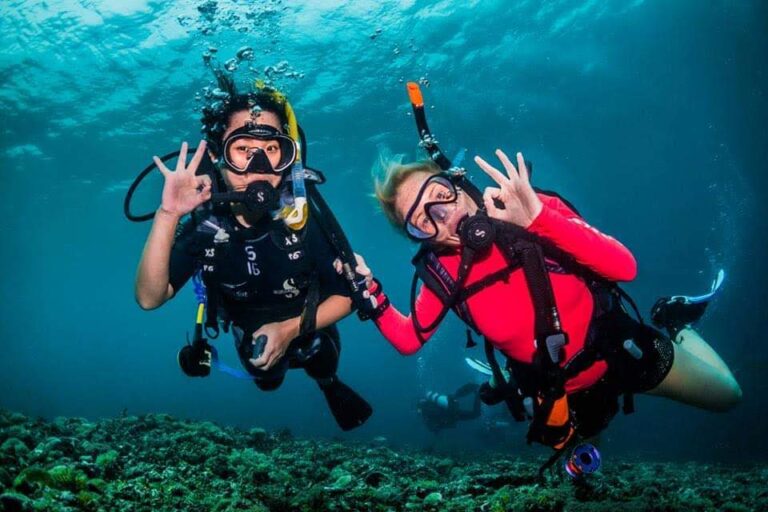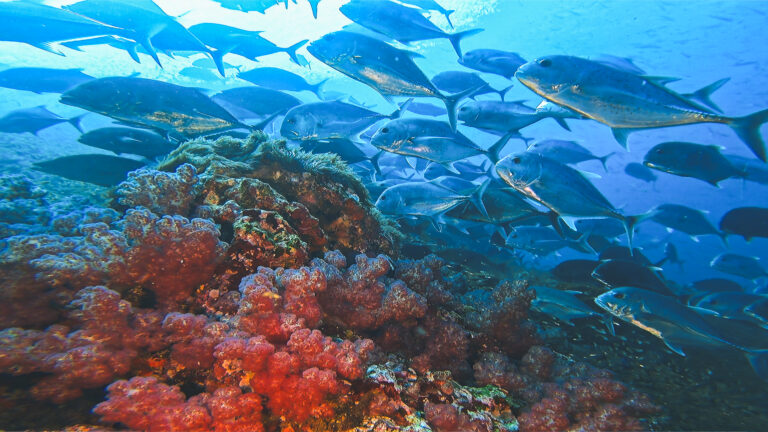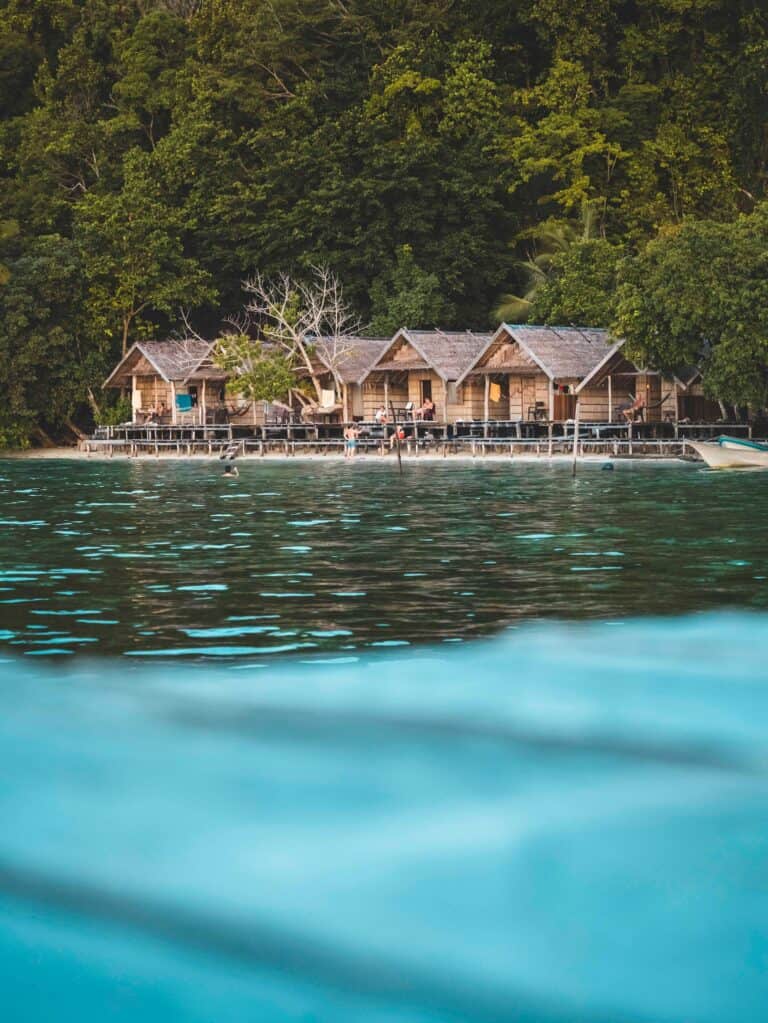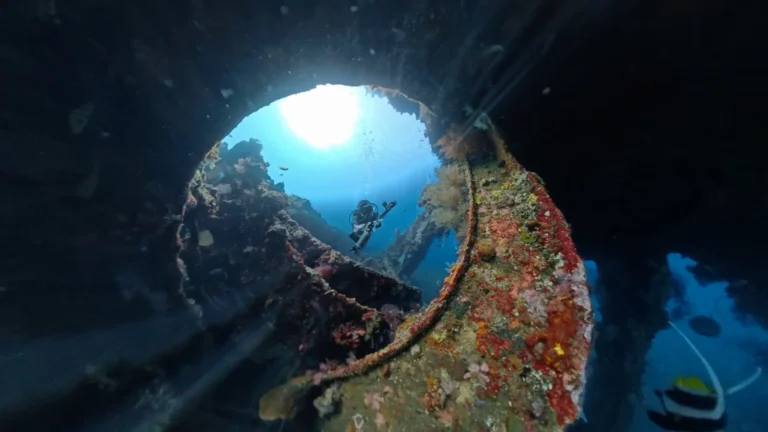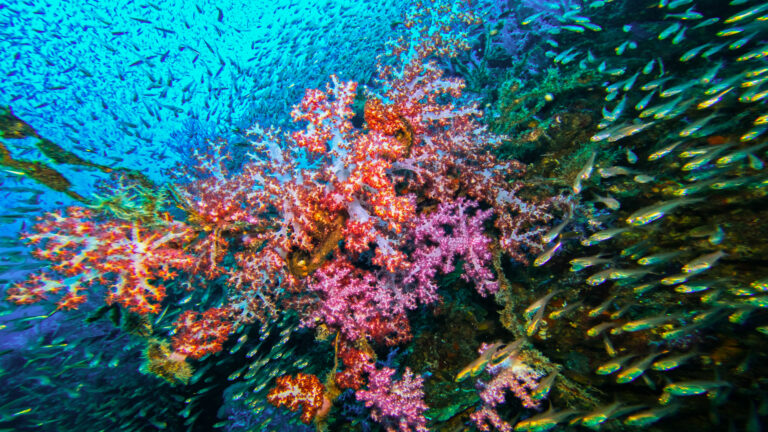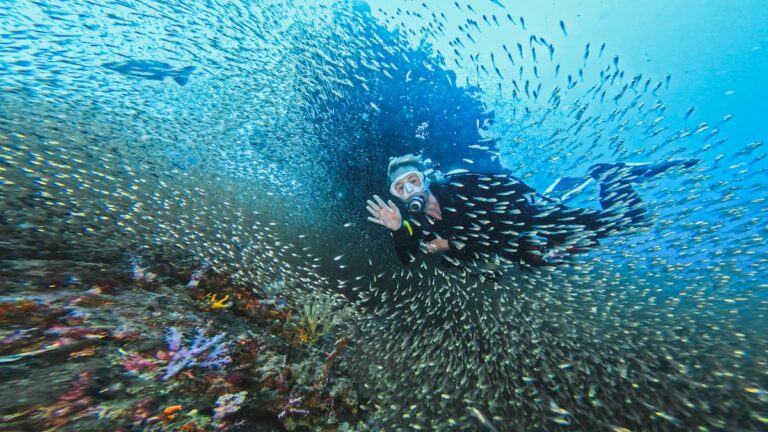Staying at a Dive Resort in Raja Ampat – Our Experience at Biodiversity Nature Resort
Raja Ampat is often called the “last paradise” — a place of incredible reefs, rare species, huge biodiversity both on the reefs and on-land, all set amongst stunning limestone karsts and white sand-rimmed rainforest islands. But if you’re planning a trip, you’ll quickly find there are several ways to dive here: liveaboards, dive safaris, base camps, and luxury dive resorts.
Most crucially, choosing an operator who upholds diving standards and eco-friendly practices is vital. Having spent several months here in 2019 and returning again in 2025, we’ve witnessed heartbreaking signs of coral death, damage, and bleaching. Raja Ampat’s increased fame amongst tourists has put the reefs under immense pressure: careless fin kicks, inexperienced divers struggling in current, and the distraction of cameras and GoPros are all leaving scars on this irreplaceable ecosystem. Too often, dive guides fail to hold divers and themselves to the standards they agree to when entering this fragile marine park.
Something has to change — and quickly — if this “last paradise” is to recover and thrive for future generations.
We’ve already shared our experiences on liveaboards, dive safaris, and base camps in Raja Ampat. In this article, we’ll focus on the resort experience — and in particular, our stay at Biodiversity Nature Resort, an eco-friendly boutique resort on Gam Island.
Why Choose a Dive Resort in Raja Ampat?
A dive resort offers a very different experience compared to a liveaboard or safari. It’s ideal for:
Divers who want a balance of comfort and adventure
Couples where one partner may not dive as much (or at all)
Travellers who value flexibility and down time between dives
Instead of packing and moving daily like a dive safari, or committing to the fixed schedule of a liveaboard, a resort allows you to shape your trip at your own pace. And unlike a base camp in Waisai, you’re already surrounded by nature — with house reefs and wildlife right outside your room.
Our Stay at Biodiversity Nature Resort
We stayed in a Superior Garden Cottage, just a short stroll from the beach. The cottage had a beautiful semi-open bathroom that felt like stepping into a mini rainforest, complete with artisan details like carved woodwork and soft furnishings.
Relaxation was effortless: hammocks on the balcony, private daybeds on the beach, and shaded loungers for reading between dives. The communal dinners created a friendly, social atmosphere — perfect for swapping dive stories — while smaller seating areas meant you could retreat into solitude whenever you wanted.
The resort bar, set on the water’s edge, was a highlight each evening, with sunset cocktails and uninterrupted views across the ocean.
We did six dives with the resort’s dive centre, plus snorkelled on the house reef. Groups were kept small (max four divers per guide). Speedboats whisked us to nearby sites within minutes:
Batu Lima & Mioskon – just 5–10 minutes away, with plenty of fish action whilst being some of the easier dive sites. There should be plenty to see at both sites.
Friwen Garden – a colourful coral slope. Large trevallies hunting fusiliers, whitetip and blacktip reef sharks and pygmy seahorses can be seen.
Melissa’s Garden & Fam Slope – a full-day trip that included the iconic Piaynemo viewpoint. Melissa’s Garden remains one of our all-time favourite dive sites.
Cape Kri – around 25 minutes away, with schooling trevallies, barracuda, octopus, and reef sharks.
The house reef was a pleasant surprise — easily accessible straight from the beach at high tide – whilst being very mindful of the shallow coral, or at low tide it is exclusively accessible from the the jetty for snorkelling or relaxed diving.
Biodiversity Above the Water
The resort truly lives up to its name. Without leaving our cottage, we spotted black cockatoos, willie wagtails, butterflies, frogs, and even a Waigeo cuscus climbing in the trees. Birdwatching tours are available on request with local guides — we didn’t join one this time, but it’s a popular activity.
We loved how the resort integrates into its surroundings: frogs hopping around the bathroom, butterflies fluttering through the garden, and the cuscus cheekily known to raid cottages in search of snacks.
The Pros of Staying at a Resort
Comfort & privacy: Modern bathrooms, comfortable bedding, artisan touches, and private terraces.
Flexibility: Choose when and how much you dive, snorkel the house reef anytime, or simply relax.
Meals: Buffet-style dinners with fresh dishes, plus afternoon snacks and varied menus.
Balance: Enough social opportunities (community dinners, bar at sunset) alongside private spaces.
Eco-friendly ethos: Solar panels, drinking water stations with glasses, no straws, and a commitment to sustainability.
The Cons of Staying at a Resort
Longer boat rides to sites outside of their scope (compared to liveaboards).
Extra cost for day trips to sites around further islands, like Fam or Piaynemo.
Limited slots for iconic sites like Blue Magic, which must be pre-booked.
Dive timing flexibility: Less tied to tidal windows than liveaboards, which can affect conditions.
Resorts are perfect for relaxed diving and skill-building, but Raja Ampat’s strong currents still demand solid dive proficiency. As with all diving here, buoyancy control and respect for the reef are critical.
Sustainability & Service at Biodiversity
Biodiversity Nature Resort has a strong eco-focus:
Runs largely on solar power (with a generator back-up).
Provides filtered water dispensers and cups.
Avoids single-use plastics anywhere possible (no straws).
Employs staff from nearby Papuan and Indonesian villages.
The service was warm and personal — staff remembered our names, asked about our dives, and always made us feel welcome. Patricia, the owner, greeted us each morning and evening, setting the tone with professionalism and genuine care.
Resort vs Liveaboard vs Safari vs Base Camp
Still unsure which option is right for you? Here’s a quick comparison of the main choices in Raja Ampat diving:
| Option | Best For | Pros | Cons |
|---|---|---|---|
| Luxury Dive Resort (e.g. Biodiversity Nature Resort) | Couples, divers with non-diving partners, those wanting comfort + flexibility | – Private cottages with modern comforts – House reef access – Flexible dive scheduling – Social + private balance – Eco-friendly, supports local staff | – Longer boat rides to remote sites – Extra cost for day trips – Must pre-book popular sites – Less tide-based dive planning |
| Liveaboard (e.g. Scuba Republic Jaya & Epica) | Hardcore divers focused on underwater time & remote sites | – Access to most sites – Tide-timed diving – Floating accommodation – Social adventure vibe | – Higher cost – Less privacy – Limited local culture connection |
| Dive Safari | Adventurers seeking island-hopping + culture + diving | – Stay in Papuan homestays – Cultural immersion – Affordable middle ground – Flexible dive planning | – Very basic comfort – Daily packing/unpacking – Smaller boats, packed lunches |
| Base Camp (Waisai) | Divers doing check dives or short visits | – Great for check dives – Access to central sites – Budget-friendly – Private boat/guide hire | – Not for beginners – Limited range – Longer day trips |
Final Thoughts – Our Experience at Biodiversity Nature Resort
Biodiversity Nature Resort offers something very different to a liveaboard or safari: a place where you can dive incredible reefs by day, then return to a private cottage, sunset cocktails, and the sound of the forest at night.
For us, it was the perfect blend of comfort, culture, and biodiversity. If you’re looking for a luxury dive resort in Raja Ampat that still stays true to its eco-roots, this is an excellent choice.
👉 Learn more and book directly with Raja Ampat Biodiversity Nature Resort.
Plan Your Raja Ampat Dive Trip
We’ve shared our honest experience of staying at Biodiversity Resort — but as with any dive travel, it’s always worth doing your own research and checking reviews before you book.




-
YouTube → aaron.and.cassie for upcoming Raja Ampat vlogs.
-
Instagram → @aaron.and.cassie for daily updates and stories.
-
Drop a comment to say hi — we love connecting with fellow divers!
Raja Ampat Dive Resort FAQs
Is Raja Ampat good for beginner divers?
Raja Ampat is best suited for divers with experience. Strong currents are common, so an Advanced Open Water certification with 100 dives is our advised minimum experience level for safety and enjoyment. Recent dive experience or a refresher course is also recommended. Resorts like Biodiversity can tailor dives to your level, but to protect the reef, it’s essential to have solid buoyancy skills and be comfortable in current.
What is the best dive resort in Raja Ampat?
There are several excellent resorts, but Biodiversity Nature Resort is one of the top eco-luxury choices. It combines private beach cottages and garden cottages just moments from the beach, a stunning house reef, small dive groups, and sustainable practices.
How much does it cost to stay at a Raja Ampat dive resort?
Resort prices vary depending on the level of comfort. At eco-luxury resorts like Biodiversity, rates generally include full board (meals, snacks) and diving packages are available. Expect higher costs than homestays, but with significantly more comfort and amenities.
What’s the difference between staying at a resort vs a liveaboard in Raja Ampat?
Resort diving: More comfort, private space, flexible schedules, cultural connection.
Liveaboard diving: More dive sites, better timing with tides, less travel time and more comfort between dives.
Your choice depends on whether you prioritise comfort and flexibility (resort) or maximising dive time (liveaboard).

